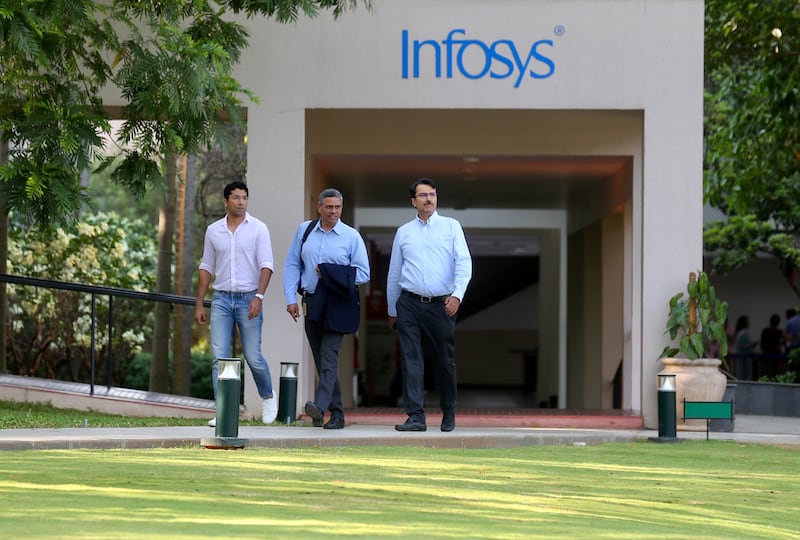Following the slump in Infosys' share price last week, analysts say India's technology industry could remain under pressure amid turmoil in the banking sector and economic concerns in the US and Europe, regions that Asia's third-largest economy counts on for revenue.
“I believe the challenges that Infosys is facing are around the slowing global growth, soaring inflationary concern, fears of a possible recession in western parts of the world, and a moderate-to-high drop in tech spend for [the first half of this financial year] post the banking crisis,” says Prashanth Tapse, senior vice president of research at Mumbai-based Mehta Equities.
He says that these factors may prompt a “slowdown in Indian IT growth” in the six months from April to September, the first half of India's fiscal year.
“At the industry level, macro uncertainties and the banking crisis in the US have impacted client sentiment on technology spends and limited visibility on near-term demand,” says Sumit Pokharna, research analyst and vice president at broker Kotak Securities.
“Discretionary IT spending cuts induce uncertainty.”
Infosys has almost become synonymous with India's IT industry.
The company, which has its headquarters in the technology centre of Bengaluru, was founded in 1981 in the city of Pune, starting out with $250 in capital.
It has since grown substantially to a market capitalisation of $62.25 billion, as of Friday.
More broadly, India's IT industry is an important part of the country's economy.
It accounted for 7.4 per cent of India’s gross domestic product in the financial year to March 2022, and it is projected to contribute 10 per cent to the country's economy by 2025, according to data from the India Brand Equity Foundation.
In the financial year to the end of March 2023, the industry's revenue is estimated to have hit a record high of $245 billion, according to the National Association of Software and Services Companies (Nasscom).
The sector has received a boost from global spending on technology and India's own domestic digital push over the past couple of years.
The industry directly employs more than five million people, Nasscom's data shows.
However, when Infosys, India's second-largest IT company, this month reported results that came in below analysts' expectations for the quarter to the end of March and issued a dismal outlook forecast, it sent the company's shares tumbling as much as 15 per cent to a two-year low of 1,185.30 rupees ($14.42) on April 17, before they regained some losses.
Infosys' share price edged lower through the course of the week, ending 11.6 per cent down at 1,227 rupees, compared with its closing price the previous week.
As investors retreated, this weighed on listed IT companies in India more broadly, with Infosys considered to be a bellwether for the sector.

Infosys reported a net profit of 61.28 billion rupees for the January-March quarter, while analysts had expected 66.24 billion, according to Refinitiv data.
It also missed revenue forecasts.
Meanwhile, it projects revenue growth of 4 per cent to 7 per cent in the current financial year, which runs until the end of March 2024, compared with analysts' expectations of 10 per cent.
“Infosys reported disappointing operating performance,” says Dipeshkumar Mehta, senior research analyst at Emkay Global Financial Services.
“Unplanned ramp-down of projects, delays in decision-making and some one-off revenue impacts, including a few client-specific project cancellations hit revenue growth.”
It will be interesting to see how the company steers through this difficult phase, says Manish Chowdhury, head of research at broker Stoxbox.
“We believe that Infosys is facing headwinds from the weakening global macro environment, and its North American business is facing the heat as discretionary projects are taking a back seat and decision-making cycle is becoming longer.”
Infosys' weak outlook followed market leader Tata Consultancy Services' lacklustre quarterly report.
“We expect some more pain for the IT sector in the near future,” says Mr Chowdhury.
The sector generates a quarter of its revenue from the banking, financial, insurance and services sectors in the US and Europe, according to Reuters.
In a research note last month, JP Morgan Chase warned that “the collapse of Silicon Valley Bank, Signature Bank and concerns of liquidity across US and the European Union can further soften tech spends by banks over the short term in a year with slowing growth in bank tech budgets”.
It highlighted that Infosys and TCS had high exposure to regional banks in the US, which account for 2 per cent to 3 per cent of their revenue.
“The top priority for the banks in US now would be to survive the crisis and maintain adequate liquidity margin and capital adequacy, which would also lead to a more cautious approach to IT spending,” says Mr Tapse of Mehta Equities.
Aside from the banking turmoil, India's IT industry had already been facing some headwinds from the global macroeconomic environment even as the surge in spending on technology triggered by the Covid-19 pandemic has faded.
“We believe that the Indian IT sector is witnessing a recalibration of [this year's] earnings estimates in tune with the latest global demand scenario,” says Trideep Bhattacharya, chief investment officer responsible for equities at Edelweiss Asset Management.
“The recent results of some leading IT companies are … leading to a consensus earnings downgrade of 4 per cent to 8 per cent.”
However, analysts are largely optimistic that the long-term prospects of Infosys are still very much intact.
“Overall, we believe that sector growth prospects are likely to be muted for the near term but a growth bounce-back cannot be ruled out in [the second half of the year] — unless major macro risks unfold in US or Europe,” says Sandeep Gogia, managing director of investment banking at Equirus.
“We are in the midst of digital and cloud adoption journey of clients which is widespread across many industries and which can result in better growth prospects starting in the next financial year.”
Naysar Shah, chief investment officer at Credent Asset Management, says the fall in Infosys' share price “is a near-term blip”.
“The company has been a tremendous wealth creator since its listing in the mid-90s and also has had several sharp declines in its journey, in spite of which the stock has delivered an 18 per cent compound annual growth rate return over the last two decades,” he says.
“The IT index has unperformed but we still believe Indian IT remains a strong structural story.
“Digital transformation and cost optimisation are the two main drivers for IT services. Once these regain momentum the sector is expected to do well.
“Management commentary suggests that the pipeline of projects is strong but the conversion is taking a little longer.”
Mr Pokharna says the silver lining for Infosys is that the “large-deal pipeline remains near all-time highs and includes several mega deals”.
“Post the recent correction in the stock price, valuations have improved,” he says, explaining Kotak Securities remains positive on Infosys, with a “buy” rating on its stock.
“We expect a quick resolution to the global banking crisis,” he says.
Meanwhile, Mr Tapse says the prospects for India's IT sector remain promising.
“For the longer-term scenario, we would remain optimistic as the world needs tech and that would lead the sector's growth going forward.”






